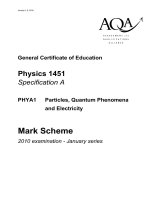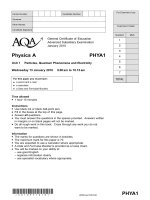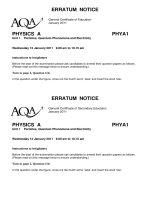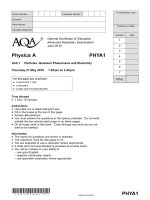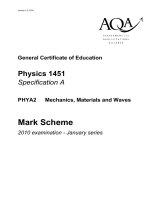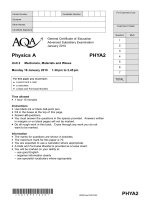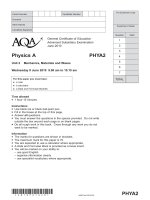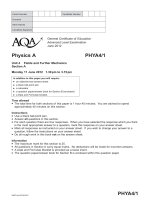- Trang chủ >>
- Khoa Học Tự Nhiên >>
- Vật lý
AQA PHYA4 2 w QP JAN10
Bạn đang xem bản rút gọn của tài liệu. Xem và tải ngay bản đầy đủ của tài liệu tại đây (84.15 KB, 12 trang )
(JAN10PHYA4201)
WMP/Jan10/PHYA4/2
PHYA4/2
Centre Number
Surname
Other Names
Candidate Signature
Candidate Number
General Certificate of Education
Advanced Level Examination
January 2010
Time allowed
●
The total time for both sections of this paper is 1 hour 45 minutes.
You are advised to spend approximately one hour on this section.
Instructions
●
Use black ink or black ball-point pen.
●
Fill in the boxes at the top of this page.
●
Answer all questions.
●
You must answer the questions in the spaces provided. Answers written
in margins or on blank pages will not be marked.
●
Do all rough work in this book. Cross through any work you do not
want to be marked.
Information
●
The marks for questions are shown in brackets.
●
The maximum mark for this section is 50.
●
You are expected to use a calculator where appropriate.
●
A Data and Formulae Booklet is provided as a loose insert.
●
You will be marked on your ability to:
– use good English
– organise information clearly
– use specialist vocabulary where appropriate.
For this paper you must have:
●
a calculator
●
a ruler
●
a Data and Formulae Booklet.
Physics A PHYA4/2
Unit 4 Fields and Further Mechanics
Section B
Thursday 28 January 2010 1.30 pm to 3.15 pm
MarkQuestion
For Examiner’s Use
Examiner’s Initials
TOTAL
1
2
3
4
WMP/Jan10/PHYA4/2
2
Areas outside
the box will
not be scanned
for marking
1 (a) Describe the energy changes that take place as the bob of a simple pendulum makes
one complete oscillation, starting at its maximum displacement.
(2 marks)
1 (b) Figure 1
Figure 1 shows a young girl swinging on a garden swing. You may assume that the
swing behaves as a simple pendulum. Ignore the mass of chains supporting the seat
throughout this question, and assume that the effect of air resistance is negligible.
15 complete oscillations of the swing took 42s.
1 (b) (i) Calculate the distance from the top of the chains to the centre of mass of the girl
and seat. Express your answer to an appropriate number of significant figures.
answer = m
(4 marks)
Answer all questions.
You are advised to spend approximately one hour on this section.
(02)
3
Areas outside
the box will
not be scanned
for marking
1 (b) (ii) To set her swinging, the girl and seat were displaced from equilibrium and
released from rest. This initial displacement of the girl raised the centre of mass
of the girl and seat 250 mm above its lowest position. If the mass of the girl was
18 kg, what was her kinetic energy as she first passed through this lowest point?
answer = J
(2 marks)
1 (b) (iii) Calculate the maximum speed of the girl during the first oscillation.
answer = m s
–1
(1 mark)
1 (c) Figure 2
On Figure 2 draw a graph to show how the kinetic energy of the girl varied with time
during the first complete oscillation, starting at the time of her release from maximum
displacement. On the horizontal axis of the graph, T represents the period of the
swing. You do not need to show any values on the vertical axis.
(3 marks)
Turn over
ᮣ
WMP/Jan10/PHYA4/2
(03)
12
0
0 T/2
time
T
kinetic
energy
WMP/Jan10/PHYA4/2
4
Areas outside
the box will
not be scanned
for marking
2 (a) A capacitor, initially charged to a pd of 6.0 V, was discharged through a 100 kΩ resistor.
A datalogger was used to record the pd across the capacitor at frequent intervals. The
graph shows how the pd varied with time during the first 40 s of discharge.
2 (a) (i) Calculate the initial discharge current.
answer = A
(1 mark)
2 (a) (ii) Use the graph to determine the time constant of the circuit, giving an appropriate
unit.
answer =
(4 marks)
(04)
0
0 102030
time/s
40
2
4
pd/V
6
5
Areas outside
the box will
not be scanned
for marking
2 (a) (iii) Hence calculate the capacitance of the capacitor.
answer = µF
(1 mark)
2 (a) (iv) Show that the capacitor lost 90% of the energy it stored originally after about 25 s.
(3 marks)
2 (b) In order to produce a time delay, an intruder alarm contains a capacitor identical to the
capacitor used in the experiment in part (a). This capacitor is charged from a 12 V
supply and then discharges through a 100 kΩ resistor, similar to the one used in the
experiment.
2 (b) (i) State and explain the effect of this higher initial pd on the energy stored by this
capacitor initially.
(2 marks)
2 (b) (ii) State and explain the effect of this higher initial pd on the time taken for this
capacitor to lose 90% of its original energy.
(1 mark)
Turn over
ᮣ
WMP/Jan10/PHYA4/2
(05)
12
WMP/Jan10/PHYA4/2
6
Areas outside
the box will
not be scanned
for marking
3 (a) (i) State the relationship between the gravitational potential energy, E
p
, and the
gravitational potential, V, for a body of mass m placed in a gravitational field.
(1 mark)
3 (a) (ii) What is the effect, if any, on the values of E
p
and V if the mass m is doubled?
value of E
p
value of V
(2 marks)
3 (b) Figure 3
Figure 3 shows two of the orbits, A and B, that could be occupied by a satellite in
circular orbit around the Earth, E.
The gravitational potential due to the Earth of each of these orbits is:
orbit A – 12.0 MJ kg
–1
orbit B – 36.0 MJ kg
–1
.
3 (b) (i) Calculate the radius, from the centre of the Earth, of orbit A.
answer = m
(2 marks)
(06)
A
E
B
7
Areas outside
the box will
not be scanned
for marking
3 (b) (ii) Show that the radius of orbit B is approximately 1.1 × 10
4
km.
(1 mark)
3 (b) (iii) Calculate the centripetal acceleration of a satellite in orbit B.
answer = m s
–2
(2 marks)
3 (b) (iv) Show that the gravitational potential energy of a 330 kg satellite decreases by
about 8 GJ when it moves from orbit A to orbit B.
(1 mark)
3 (c) Explain why it is not possible to use the equation ∆E
p
= mg∆h when determining the
change in the gravitational potential energy of a satellite as it moves between these
orbits.
(1 mark)
Turn over
ᮣ
WMP/Jan10/PHYA4/2
(07)
10
WMP/Jan10/PHYA4/2
8
Areas outside
the box will
not be scanned
for marking
4 (a) (i) Outline the essential features of a step-down transformer when in operation.
(2 marks)
4 (a) (ii) Describe two causes of the energy losses in a transformer and discuss how these
energy losses may be reduced by suitable design and choice of materials.
The quality of your written communication will be assessed in this question.
(08)
9
Areas outside
the box will
not be scanned
for marking
(6 marks)
4 (b) Electronic equipment, such as a TV set, may usually be left in ‘standby’ mode so that
it is available for instant use when needed. Equipment left in standby mode continues
to consume a small amount of power. The internal circuits operate at low voltage,
supplied from a transformer. The transformer is disconnected from the mains supply
only when the power switch on the equipment is turned off. This arrangement is
outlined in Figure 4.
Figure 4
When in standby mode, the transformer supplies an output current of 300 mA at 9.0 V
to the internal circuits of the TV set.
4 (b) (i) Calculate the power wasted in the internal circuits when the TV set is left in
standby mode.
answer = W
(1 mark)
Question 4 continues on the next page
Turn over
ᮣ
WMP/Jan10/PHYA4/2
(09)
power
switch
mains
supply
at 230V
to internal
circuits
at 9.0V
transformer
WMP/Jan10/PHYA4/2
10
Areas outside
the box will
not be scanned
for marking
4 (b) (ii) If the efficiency of the transformer is 0.90, show that the current supplied by the
230 V mains supply under these conditions is 13 mA.
(2 marks)
4 (b) (iii) The TV set is left in standby mode for 80% of the time. Calculate the amount of
energy, in J, that is wasted in one year through the use of the standby mode.
1 year = 3.15 × 10
7
s
answer = J
(1 mark)
4 (b) (iv) Show that the cost of this wasted energy will be about £4, if electrical energy is
charged at 20 p per kWh.
(2 marks)
4 (c) The power consumption of an inactive desktop computer is typically double that of a
TV set in standby mode. This waste of energy may be avoided by switching off the
computer every time it is not in use. Discuss one advantage and one disadvantage of
doing this.
(2 marks)
END OF QUESTIONS
(10)
16
WMP/Jan10/PHYA4/2
(11)
11
There are no questions printed on this page
DO NOT WRITE ON THIS PAGE
ANSWER IN THE SPACES PROVIDED
WMP/Jan10/PHYA4/2
(12)
12
There are no questions printed on this page
DO NOT WRITE ON THIS PAGE
ANSWER IN THE SPACES PROVIDED
Copyright © 2010 AQA and its licensors. All rights reserved.
